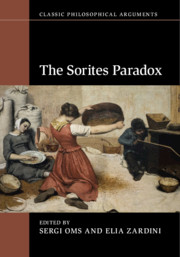Book contents
- Frontmatter
- Contents
- List of Contributors
- Acknowledgements
- Prelude
- Part I Solutions to the Sorites Paradox
- 1 Epistemicism and the Sorites Paradox
- 2 Supervaluationism, Subvaluationism and the Sorites Paradox
- 3 Contextualism and the Sorites Paradox
- 4 Incoherentism and the Sorites Paradox
- 5 Intuitionism and the Sorites Paradox
- 6 Rejection of Excluded Middle and the Sorites Paradox
- 7 Dialetheism and the Sorites Paradox
- 8 Degree Theory and the Sorites Paradox
- 9 Non-Transitivism and the Sorites Paradox
- Part II The Influence of the Sorites Paradox
- Coda
- References
- Index
5 - Intuitionism and the Sorites Paradox
from Part I - Solutions to the Sorites Paradox
Published online by Cambridge University Press: 20 September 2019
- Frontmatter
- Contents
- List of Contributors
- Acknowledgements
- Prelude
- Part I Solutions to the Sorites Paradox
- 1 Epistemicism and the Sorites Paradox
- 2 Supervaluationism, Subvaluationism and the Sorites Paradox
- 3 Contextualism and the Sorites Paradox
- 4 Incoherentism and the Sorites Paradox
- 5 Intuitionism and the Sorites Paradox
- 6 Rejection of Excluded Middle and the Sorites Paradox
- 7 Dialetheism and the Sorites Paradox
- 8 Degree Theory and the Sorites Paradox
- 9 Non-Transitivism and the Sorites Paradox
- Part II The Influence of the Sorites Paradox
- Coda
- References
- Index
Summary
The vagueness-intuitionist credits epistemicism with a crucial insight, namely that vagueness is a cognitive, rather than a semantic phenomenon: the vagueness of the distinction between, say, yellow and orange consists in our inability to, so to speak, bring those two concepts up against one another to mark a sharp and stable boundary. The chapter proposes a knowledge-theoretic semantics for a first-order logic of vagueness that respects this conception of the nature of the phenomenon. The semantics diverges from traditional intuitionist-style semantics (Heyting, Beth, Kripke) in the treatment of negation, taking the idea of incompatibility between atomic vague predications as primitive, and setting the negation of atomic A as acceptable just when some statement is acceptable which is incompatible with A. It is shown how a semantics based on this idea vindicates an intuitionist-style repudiation of the principle of Bivalence and thereby the law of excluded middle, and thus enables the reasoning of the Sorites Paradox to go through as a demonstration of the negation of its major premisewithout thereby incurring the unwelcome implication, sustained by classical logic, of the existence of a sharp boundary to the extension of the relevant predicate.
- Type
- Chapter
- Information
- The Sorites Paradox , pp. 95 - 117Publisher: Cambridge University PressPrint publication year: 2019

